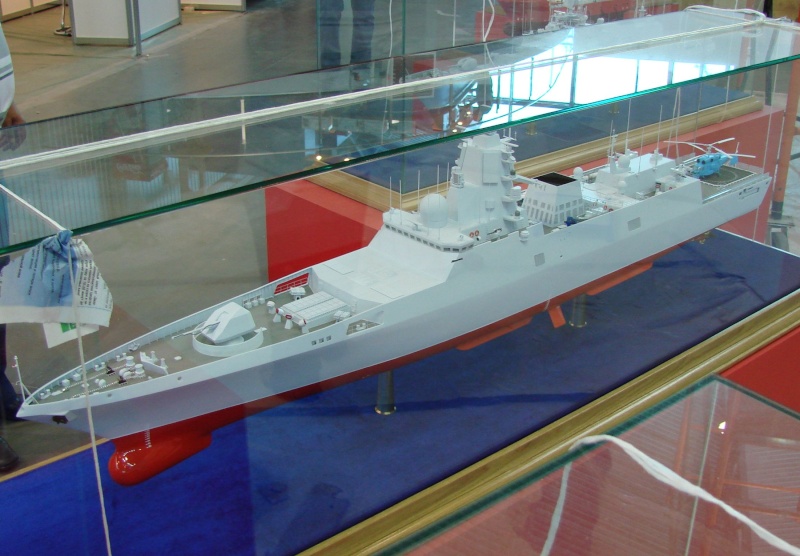
But of course a model is easy to make... and change

It could fire antiship, antisubmarine, land-attack cruise missiles, torpedoes, and possibly SAMs.
I have heard that the Russian Navy will get some modified Talwar frigates that were designed for India... that were actually very good ships, and this should speed up production, though some of the weapons to be fitted are a problem (Poliment radar and the Redut missiles to go with it).
GarryB wrote:The best way for the Russian ship building industry to recover is for them to get large contracts and start building ships.
Larger orders and longer production runs are another positive consequence of standardisation of ship components and systems.
GarryB wrote:
I have heard that the Russian Navy will get some modified Talwar frigates that were designed for India... that were actually very good ships, and this should speed up production, though some of the weapons to be fitted are a problem (Poliment radar and the Redut missiles to go with it).
Ι think Talwar frigates (6 ordered) is the best short-term solution for black sea fleet which desperately needs new warships. The first ship will be delivered in the beginning of 2013 (keel laid down in 2010), very fast for the Russian shipbuilding reality
I think 6 is overkill in terms of resources allocated to the BSF, better send those 2 of those hulls to Pacific and 1 to North.
They will likely be very close to the Indian ships to expedite construction, hopefully they get VLS Shtil, at best there might be Redut like the 20380s, but no Poliment, though I find that unlikely personally.


The Project 22350 Admiral Golovko frigate and the Project 20385 Gremyashchy corvette will be built at the Severnaya Verf (Northern Shipyard) in St. Petersburg, he said.
Navy Found Alternative to Arsenal Plant
20.12.11
Being displeased with execution of the contract for ship-based 100-mm gun mounts A-190 Universal by JSC Arsenal Machinery Plant (St. Petersburg), Russian Navy has found another executor – Burevestnik Central Research Institute (Nizhniy Novgorod).
Complaints of the Navy's officials were about both quality of gun mounts and protractions of deliveries. Things went so bad that the Navy Commander-in-Chief Admiral Vysotsky visiting Severnaya Verf shipyard told to shipbuilders and designers that the Navy would have to buy guns in the West if nothing improved.
We remind that the project of A-190 gun mount was designed by the Burevestnik research institute on the basis of well-mastered and batch-produced gun mount AK-176M (both for Soviet/Russian Navy and for export). Documentation for batch production was handed over to the Arsenal plant in St. Petersburg. Early in 2000's the plant produced first gun mounts for Project 11356 frigates built by Baltiysky Zavod shipyard for India. According to unofficial information, the guns were unfinished and are still used in Indian Navy with some restrictions.
Despite the immature design, the gun had quite powerful potential. Thanks to its light weight (more than two times lighter than its predecessor – AK-100 gun mount) and advanced ballistic features, it could be mounted on smaller ships and even boats. The gun was included into armament of Russian Navy's newest ships – Project 20380 corvette Stereguschiy and Project 21630 small-size gunnery ship Astrakhan. By the way, the latter one became the first ship in Russian Navy armed with that gun mount.
Technical problems inevitably arisen after introduction of the new weapon system in service provoked long-lasting workout and still have not been resolved. In addition to the hardware problems, the monopolist Arsenal plant failed to meet a schedule and deliver gun mounts in time. That directly affected delivery dates of the ships. For instance, second Project 21630 small-size gunnery ship Volgodonsk built by JSC Almaz Shipbuilding Firm (St. Petersburg) started test firings of major caliber gun just a while ago, almost half a year behind schedule. Another fact must be mentioned here. Launched in spring without gun mount, the ship took part in the International Maritime Defense Show. For that purpose, the gun mount being tested at Rzhevka Range was hastily mounted on the ship, but right after the show it was dismantled and sent back to Rzhevka. The gun was finally mounted on Volgodonsk for trials only in September.
Seeing that JSC Arsenal Machinery Plant failed to complete contracts in time (including export ones for gun mounts AK-176M) and – according to Admiral Vysotsky – "groundlessly drove up prices", the Navy had to seek for a different gun supplier and chose Burevestnik Central Research Institute (Nizhniy Novgorod). It is the leading developer of cannon artillery for Russian Army and Navy. Except for developing of new artillery systems, the institute has own production facilities and is capable to manufacture weapons in lots. It was the Burevestnik institute who had developed the Universal gun system late in 80's, and that was another reason for selection. It was proposed to find alternative supplier of A-190 guns far back in 2010, but only in this year defense ministry formed the order for a batch of 10-mm gun mounts for new Russian frigates and corvettes. JSC Motovilikha Works was engaged as the Burevestnik's contractor in order to produce tipping parts for the guns. Being located in Perm, this company is the oldest and the most experienced manufacturer of field and self-propelled artillery and MLRS systems claiming to be the Russia's number one artillery producer.
The contract cost is noteworthy as well. According to the president of JSC United Shipbuilding Corporation Roman Trotsenko, the price would be 30% less than the Arsenal plant demanded.
As may be supposed, gun systems built by the Burevestnik institute jointly with the Motovilikha plant would be mounted on Project 11356 frigates (first 3-ship batch is being constructed by Yantar Shipyard, plans to build other 3 frigates have been already voiced), and a series of Project 20380/20385 corvettes built by Severnaya Verf shipyard in St. Petersburg and Amur Shipyard at the Far East.
Basic characteristics of A-190 Universal 100-mm ship-based gun mount
Firing rate – about 80 rounds per minute
Lateral firing range – 21,000 meters
Altitude capability – 15,000 meters
Elevation angle – from minus 15 to plus 85 degrees
Horizontal pointing angle – from minus to plus 170 degrees
Shell weight – 15.6 kg
Ammunition load – 80 shells
Gun mount weight – about 15 tons
The system uses fixed munitions with high-explosive impact-fuzed shells and anti-aircraft radar-fuzed projectiles. In prospect, use of guided missiles is possible as well.
Key advantages of A-190 gun mount:
fully automated combat operating mode with use of main and reserve control methods in severe jamming environment
minimal dead zones when firing at different targets
reaction time when repelling air attacks – 2-5 seconds, rapid shift of fire between targets
A-190 guns have been already mounted on Russian warships of several projects (20380, 20385, 21630, 21631, 11356 – stealth shielded variant A-190-01) and Indian Navy's ships (Project 11356/17 frigates – export variant A-190E).

Frigate Project 22350 "Admiral Kasatonov" will be handed over to the Navy Russia in 2014, the lead ship of this project, "Admiral Gorshkov" - in 2012, said on Wednesday in St. Petersburg Chief of Navy Admiral Vladimir Vysotsky.
He also said that currently under a lot of work on the design of prospective destroyer. According to the Commander in Chief, the displacement of the ship will be twice the displacement of currently existing U.S. Navy cruisers. He will have a different power plant, said Vysotsky.
Previously, he reported that the destroyer type ships can be equipped with nuclear power plant. The Commander said that the ships of this type - this is a very complex projects, more work is required in the design offices and in the future, large financial investments."This prospect, where we're now" - he said.
The need for the Russian Navy in project 22350 frigates, such as "Admiral Gorshkov" will make the next 15-20 years to 20 ships, told RIA Novosti on Wednesday in St. Petersburg spokesman shipbuilding factory "Northern Shipyard" Olga Wilde. "Over the next 15-20 years, the need for the Russian Navy frigates in up to 20 ships. The basis for the future frigates should be the ships of project 22350, which have universal capabilities to carry out combat missions as a single voyage, and as part of groups," - said Wilde.
Shipyard "Northern Shipyard" in St. Petersburg will build for the Navy of Russia 10 20 385 corvette project (Project 20380-type modernized "Guarding"), told RIA Novosti on Wednesday in St. Petersburg Company spokeswoman Olga Wilde.
On Wednesday, a staple of the "Northern Shipyard", an official ceremony of laying the first head corvette "Gremiashchii" Project 20 385.. The project was developed in design office "Diamond" is the result of the modernization project 20380. On the same day at the plant were laid Project 22350 frigate "Admiral Golovko" for the Russian Navy.
"RF Government Shipyard" Northern Shipyard "was appointed the sole supplier of a further nine units upgraded corvette 20 385 project for the Russian Navy," - said Wilde.
According to her, the Russian Navy is interested in the completion of combat surface ships such forces. "His need for up to 20 units," - said Wilde.

Project 22350 multipurpose frigates developed by Severnoye Design Bureau are large seagoing warships capable to accomplish wide range of tasks. Design displacement is 4,500 tons; length is 130 meters; beam is 16 meters; draft is 4.5 meters; max speed 30 knots. Ships of the project are armed with Caliber-NK missile system with 32 Onyx and Caliber missiles capable to hit sea and coastal targets, Poliment-Redut SAM system, Paket ASW system, one 130-mm gun mount A-192, two Palash gun/missile close-in systems, and Ka-27PL ASW helicopter.

TR1 wrote:I am 100% positive 16.
Redut-Poliment likely 32.
|
|
|